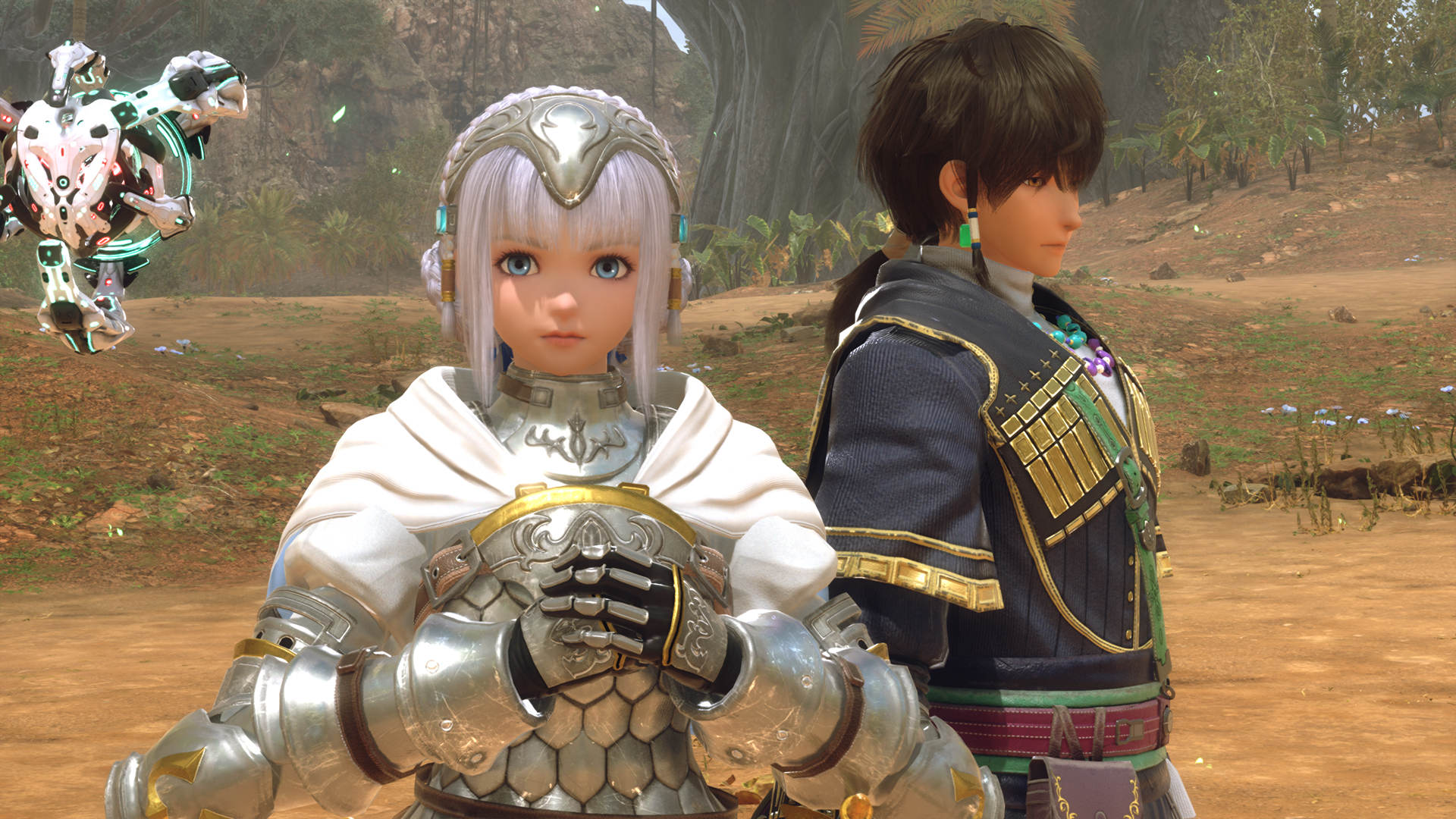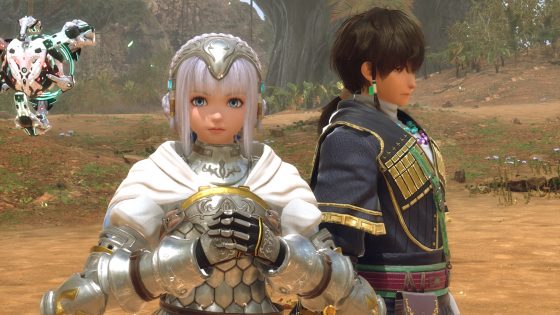

Game Info:
- System: PS4, PS5, PC, Xbox One, XSX
- Publisher: Square Enix
- Developer: tri-Ace
- Release Date: October 27, 2022
- Pricing:$59.99
- Rating: T
- Genre: Action JRPG
- Players: 1
- Official Website: https://starocean.square-enix-games.com/en-us/

Star Ocean: The Divine Force is the sixth and latest entry into developer tri-Ace’s overall Star Ocean universe, and an earnest attempt to atone for the poorly-received 2016 outing, Integrity and Faithlessness. The Divine Force is a hugely ambitious title, and succeeds more often than it stumbles, with fast-paced gameplay and an excellent story. Here at Honey’s Anime, we’re newcomers to the world of Star Ocean, with The Divine Force being our first foray into the series—so we’re reviewing the title based on how it compares to other JRPGs on the market. Whether you’re fresh to the franchise, or a Star Ocean veteran, we think The Divine Force is a great JRPG, and definitely not one to sleep on! Join us today on Honey’s Anime as we review Star Ocean: The Divine Force!
Two Worlds of Technology

The Divine Force’s story plays out differently depending on which main character you choose—either Raymond “Ray” Lawrence, a spaceship captain marooned on an underdeveloped planet; or Laeticia Aucerius, a princess of an embattled kingdom on that same planet. For our playthrough we chose Laeticia, and although much of the story sees her and Ray working together, there are significant patches of gameplay where their stories diverge. This offers quite the incentive for replay value since the story is so engaging that we’d love to know what our companions were up to off-screen. The story really does sing in The Divine Force—a beautiful combination of hi-tech and lo-tech coming together in a surprisingly harmonious manner. Laeticia and her companions must come to grips with worlds beyond the stars, despite their Renaissance-era society having just barely progressed into naval combat. Her kingdom hovers on the edge of war with the neighboring empire, and the politics of her own kingdom press down on her and her father, the king. The surprisingly deep politics are worthy of any fantasy novel, and that’s before we throw in Raymond and his crew.

For his part, Ray finds himself stranded on this underdeveloped planet after his ship was attacked and destroyed in orbit. His crew is scattered across this underdeveloped planet, and he joins forces with Laeticia to help find his missing crewmates. Along the way, it becomes obvious that their goals are aligned since Ray isn’t the only otherworlder disturbing the natural course of events on this planet. Over the course of our playthrough, we were consistently impressed by the excellent characterization, matched by a stellar English voice-acting cast. For once, this is a JRPG where the characters make logical decisions based on their personalities and the stakes at hand; and certain mid-game plot twists genuinely had us quite moved. Star Ocean’s “Private Actions” return, allowing you to have in-depth discussions with your favorite characters, revealing more of their personalities, hopes, and dreams—but that’s not your only chance to learn about your allies. Like many modern JRPGs, The Divine Force’s cast are constantly chattering away as you explore the world, giving you continuous insight into how they’re feeling about the story’s events or even each other.
Bringing a Sword to a Phase Gun Fight

The Divine Force’s gameplay is fast and visceral, coming up somewhere between Tales of Arise and Final Fantasy XV. With the assistance of a robotic probe named “D.U.M.A.,” your character is able to take flight both in and out of battle, adding even more freedom to your combat. Battles in The Divine Force play out in real-time, as per usual for the franchise, and are seamless encounters on the world map. Damage is dished out with combo attacks mapped to the face buttons on the controller, and you can unlock new attacks through the game’s skill tree (more on that later). Combat is insanely fast, but never feels too hectic—it’s perfectly paced, although it can take a while to feel like you’re truly understanding the ebb and flow of battle. Every attack consumes AP (action points), and extra AP is gained by getting the upper hand on the enemy. One of the best ways to outwit enemies is through the game’s flight and dashing mechanics.

By holding the shoulder button, your character will hover in the air with a protective shield; releasing the button will see you zoom toward an enemy at high speed. With a twitch of your left stick, you can change direction at the last moment to execute a “Blindside” move that will stun the enemy, allowing you to deal extra damage and increase your AP cap. This rhythm—backing away, allowing AP to recharge, then dashing in for a blindside—makes up most of the game’s combat. The AI-controlled characters are reasonably smart, and can be directed to focus on your enemy, or do their own thing. You can also pause combat entirely to select potions and consumables, or just to take stock of the battle. Switching playable characters is easy, although we spent most of our time with Laeticia; that said, it’s important that you set your AI companion’s skills correctly since they’ll only use items and abilities you’ve assigned to them.
New Horizons

Outside of combat, you’ll be exploring a vast open world that takes you from gorgeous, lush forests, to towering snow-capped peaks, all the way up into the stars and onto space stations. These large areas are easy to traverse thanks to the short flight mechanic you can use, similar to Bioware’s Anthem, allowing you to zip past enemies, or even reach treasure chests hidden in various parts of the map. In towns and cities, you’ll be flying across rooftops to collect upgrade points or find collectables. The flight mechanic, simple though it sounds, is honestly our favorite part of The Divine Force’s gameplay, and makes exploration a real joy. We wished the game allowed you to climb, though, since we frequently got ourselves close to the edge of a building, only to fall helplessly—but at least there’s no fall damage. A fair amount of your time will be spent in the menu system, like any JRPG. Characters in The Divine Force don’t immediately get new stats when they level up—instead, they’ll receive Skill Points (SP) that can be spent in a number of ways.

Each character has a branching skill tree that allows you to increase their stats, or unlock new passive or combat abilities. You can also use SP to strengthen those unlocked abilities, allowing you to deal more damage or reinforce passive buffs. Choosing whether to go for that shiny new skill or instead strengthen an existing one is a delicate balance that you’ll need to figure out for yourself over the course of the game, depending on your own play style. The Divine Force also offers a crafting system, which takes some dedication to unlock. The system is entirely optional, locked behind a series of side quests, but sinking time—and more SP—into crafting allows you to produce upgraded versions of items you can usually buy in-store. You can also compound medicine, which—at least in the early game—is far cheaper than purchasing them from shops. By spending time in the system, you can even start producing rare items and weapons impossible to find in-store. Adding to your non-combat playtime is Es’owa, a board game that sees you challenging random NPCs to a modified version of Othello, complete with special abilities and health bars. It’s a fun distraction, and the pieces you unlock can even be used as equipment for your characters. We found Es’owa to be a nice little mini-game, and far more engaging than the various card games in something like Trails of Cold Steel.
A Glitch in the Matrix

It’s not all perfect, however. As we mentioned earlier, The Divine Force is an ambitious title, but not every ambition pans out. Side quests are particularly lackluster, and The Divine Force lacks any side quest tracking, which makes the fetch-and-kill quests more frustrating than they need to be. Each store in the game has quests you can complete by providing them materials, which in turn will unlock new items or give you money; but simply wandering out into the world and beating up a few frogs will net you tons of cash anyway. We also encountered plenty of graphical woes with our PS4 copy of The Divine Force. Clearly, this is a next-gen title, and from what we’ve seen, the PS5 version is far superior in graphical fidelity. On our PS4 Pro, we encountered blurry textures, frame-rate drops in cities, and hugely aliased shadows. The character models always look beautiful, but large parts of the open world are rendered quite poorly even on a PS4 Pro. If you have the option to get this on a next-gen console, we encourage you to do so. The game offers two modes—one to improve graphics, the other to improve frame rate—but we kept the game on the Frame Rate mode, simply because the Graphics mode barely improved quality and tanked the frame rate. None of these issues were really game-breaking, but they did detract from our overall experience.
Final Thoughts

Star Ocean: The Divine Force is an ambitious attempt at reviving a beleaguered franchise, and for the most part, it’s a triumphant success. The world-building is a unique blend of hi-tech sci-fi with magic-based fantasy, helped along by a cast of unique and well-acted characters, and a genuinely engaging story. Although—like many JRPGs—it takes a few hours to warm up, The Divine Force really sings when everything is working together. Despite some graphical setbacks on our PS4 Pro and some bland side quests, this new installment in the franchise is definitely worthy of any JRPG fan’s time. Are you going to play Star Ocean: The Divine Force? Let us know in the comments, and as always, thanks for reading! Note: Gameplay screenshots in this article are courtesy of Square Enix, and captured on next-gen consoles. We reviewed Star Ocean: The Divine Force on a PS4 Pro.
[recommendedPost post_id='169071' url='' title='' img='' class='' widget_title='']
